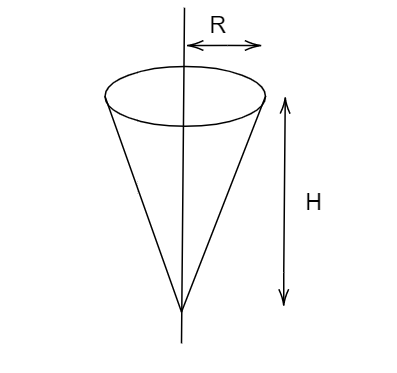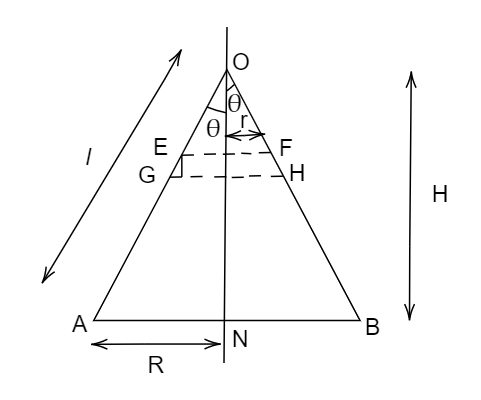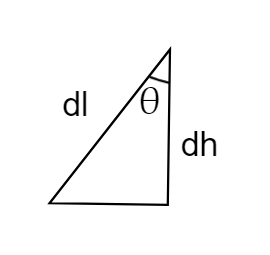
Shown in the figure is a hollow ice cream cone (it is open at the top). If its mass is M, the radius of its top, R and height, H, then find the moment of inertia about its axis.

A. \[\dfrac{{M{R^2}}}{2}\]
B. \[\dfrac{{M{R^2}}}{3}\]
C. \[\left[ {\dfrac{{M\left( {{R^2} + {H^2}} \right)}}{4}} \right]\]
D. \[\dfrac{{M{H^2}}}{3}\]
Answer
220.8k+ views
Hint:Before we proceed into this problem it is important to know about the moment of inertia. It is defined as the quantitative measure of the rotational inertia of a body.
Formula Used:
Moment of inertia about an axis ON is given by,
\[{I_{ON}} = \int {dm \times {r^2}} \]
Where, \[dm\] is mass of the differential element, \[r\] is radius of the differential element.
Complete step by step solution:
The slant height of this cone is ‘l’ with the radius of the cone R and the height of the cone is H as shown in the diagram.

Image: A hollow ice cream cone

Image: Enlarged view
Now let’s take a differential element as shown in the dotted line. The slant of the height of the differential element is dl, radius r, and height from the apex is h. Let’s consider a triangle in the differential element as shown in the diagram.
Then, \[\cos \theta = \dfrac{{dh}}{{dl}}\]
\[dl = \dfrac{{dh}}{{\cos \theta }}\]
Now we have to find the moment of inertia. If we find the moment of inertia of this differential element, after that we can integrate it to get the moment of inertia of the whole cone.
We know that,
Area of the cone \[ = \pi Rl\]
\[ = \pi R\sqrt {{H^2} + {R^2}} \]
Now, apply Pythagoras theorem to the triangle OAN we get,
\[l = \sqrt {{H^2} + {R^2}} \]………(1)
Also, the area of the element= area of the rectangle EFGH
i.e., the Area of the element \[ = 2\pi rdl\]
By substituting the value \[dl\] we obtain,
Area of the element \[ = 2\pi r\dfrac{{dh}}{{\cos \theta }}\]
Suppose \[\dfrac{M}{A} = \lambda \]
Mass of the element, \[dm = \lambda \times \text{(area of element)}\]
\[dm = \lambda \times \left( {2\pi r\dfrac{{dh}}{{\cos \theta }}} \right)\]
Substituting the value of \[\lambda \] and area of the cone we get,
\[dm = \dfrac{M}{{\pi Rl}} \times \left( {2\pi r\dfrac{{dh}}{{\cos \theta }}} \right)\]
From triangle OMF, \[\tan \theta = \dfrac{r}{h}\]
\[ \Rightarrow r = h\tan \theta \]
\[dm = \dfrac{{2M\left( {h\tan \theta } \right)dh}}{{Rl\cos \theta }}\]
We have calculated the mass of different elements.
Now calculate the moment of inertia about an axis ON.
\[{I_{ON}} = \int {dm \times {r^2}} \]
\[{I_{ON}} = \int {\dfrac{{2M\left( {h\tan \theta } \right)dh{{\left( {h\tan \theta } \right)}^2}}}{{Rl\cos \theta }}} \]
Substitute the value of ‘l’ from the equation (1) we get,
\[{I_{ON}} = \int {\dfrac{{2M\left( {h\tan \theta } \right)dh{{\left( {h\tan \theta } \right)}^2}}}{{R\sqrt {{R^2} + {H^2}} \cos \theta }}} \]
Rearrange the above equation and integrate it from the limits 0 to R we get,
\[{I_{ON}} = \dfrac{{2M{{\tan }^3}\theta }}{{R\sqrt {{R^2} + {H^2}} \cos \theta }}\int\limits_0^H {{h^3}dh} \]
\[{I_{ON}} = \dfrac{{2M{{\tan }^3}\theta }}{{R\sqrt {{R^2} + {H^2}} \cos \theta }}\left[ {\dfrac{h}{4}} \right]_0^H\]
From the triangle OAN,
\[\tan \theta = \dfrac{R}{H}\], \[\cos \theta = \dfrac{H}{{\sqrt {{H^2} + {R^2}} }}\]
\[{I_{ON}} = \dfrac{{2M{{\left( {\dfrac{R}{H}} \right)}^3}}}{{R\sqrt {{R^2} + {H^2}} \left( {\dfrac{H}{{\sqrt {{R^2} + {H^2}} }}} \right)}}\dfrac{{{H^4}}}{4}\]
On simplifying the above equation we get,
\[\therefore {I_{ON}} = \dfrac{{M{R^2}}}{2}\]
Therefore, the moment of inertia about its axis ON is, \[\dfrac{{M{R^2}}}{2}\].
Hence, Option A is the correct answer
Note:In physics, a moment of inertia is a quantitative measure of a body's rotational inertia—that is, the resistance that the body shows to having its speed of rotation along an axis altered by the application of a torque. The moment of inertia depends on the mass, axis of rotation, shape and size of the body.
Formula Used:
Moment of inertia about an axis ON is given by,
\[{I_{ON}} = \int {dm \times {r^2}} \]
Where, \[dm\] is mass of the differential element, \[r\] is radius of the differential element.
Complete step by step solution:
The slant height of this cone is ‘l’ with the radius of the cone R and the height of the cone is H as shown in the diagram.

Image: A hollow ice cream cone

Image: Enlarged view
Now let’s take a differential element as shown in the dotted line. The slant of the height of the differential element is dl, radius r, and height from the apex is h. Let’s consider a triangle in the differential element as shown in the diagram.
Then, \[\cos \theta = \dfrac{{dh}}{{dl}}\]
\[dl = \dfrac{{dh}}{{\cos \theta }}\]
Now we have to find the moment of inertia. If we find the moment of inertia of this differential element, after that we can integrate it to get the moment of inertia of the whole cone.
We know that,
Area of the cone \[ = \pi Rl\]
\[ = \pi R\sqrt {{H^2} + {R^2}} \]
Now, apply Pythagoras theorem to the triangle OAN we get,
\[l = \sqrt {{H^2} + {R^2}} \]………(1)
Also, the area of the element= area of the rectangle EFGH
i.e., the Area of the element \[ = 2\pi rdl\]
By substituting the value \[dl\] we obtain,
Area of the element \[ = 2\pi r\dfrac{{dh}}{{\cos \theta }}\]
Suppose \[\dfrac{M}{A} = \lambda \]
Mass of the element, \[dm = \lambda \times \text{(area of element)}\]
\[dm = \lambda \times \left( {2\pi r\dfrac{{dh}}{{\cos \theta }}} \right)\]
Substituting the value of \[\lambda \] and area of the cone we get,
\[dm = \dfrac{M}{{\pi Rl}} \times \left( {2\pi r\dfrac{{dh}}{{\cos \theta }}} \right)\]
From triangle OMF, \[\tan \theta = \dfrac{r}{h}\]
\[ \Rightarrow r = h\tan \theta \]
\[dm = \dfrac{{2M\left( {h\tan \theta } \right)dh}}{{Rl\cos \theta }}\]
We have calculated the mass of different elements.
Now calculate the moment of inertia about an axis ON.
\[{I_{ON}} = \int {dm \times {r^2}} \]
\[{I_{ON}} = \int {\dfrac{{2M\left( {h\tan \theta } \right)dh{{\left( {h\tan \theta } \right)}^2}}}{{Rl\cos \theta }}} \]
Substitute the value of ‘l’ from the equation (1) we get,
\[{I_{ON}} = \int {\dfrac{{2M\left( {h\tan \theta } \right)dh{{\left( {h\tan \theta } \right)}^2}}}{{R\sqrt {{R^2} + {H^2}} \cos \theta }}} \]
Rearrange the above equation and integrate it from the limits 0 to R we get,
\[{I_{ON}} = \dfrac{{2M{{\tan }^3}\theta }}{{R\sqrt {{R^2} + {H^2}} \cos \theta }}\int\limits_0^H {{h^3}dh} \]
\[{I_{ON}} = \dfrac{{2M{{\tan }^3}\theta }}{{R\sqrt {{R^2} + {H^2}} \cos \theta }}\left[ {\dfrac{h}{4}} \right]_0^H\]
From the triangle OAN,
\[\tan \theta = \dfrac{R}{H}\], \[\cos \theta = \dfrac{H}{{\sqrt {{H^2} + {R^2}} }}\]
\[{I_{ON}} = \dfrac{{2M{{\left( {\dfrac{R}{H}} \right)}^3}}}{{R\sqrt {{R^2} + {H^2}} \left( {\dfrac{H}{{\sqrt {{R^2} + {H^2}} }}} \right)}}\dfrac{{{H^4}}}{4}\]
On simplifying the above equation we get,
\[\therefore {I_{ON}} = \dfrac{{M{R^2}}}{2}\]
Therefore, the moment of inertia about its axis ON is, \[\dfrac{{M{R^2}}}{2}\].
Hence, Option A is the correct answer
Note:In physics, a moment of inertia is a quantitative measure of a body's rotational inertia—that is, the resistance that the body shows to having its speed of rotation along an axis altered by the application of a torque. The moment of inertia depends on the mass, axis of rotation, shape and size of the body.
Recently Updated Pages
Two discs which are rotating about their respective class 11 physics JEE_Main

A ladder rests against a frictionless vertical wall class 11 physics JEE_Main

Two simple pendulums of lengths 1 m and 16 m respectively class 11 physics JEE_Main

The slopes of isothermal and adiabatic curves are related class 11 physics JEE_Main

A trolly falling freely on an inclined plane as shown class 11 physics JEE_Main

The masses M1 and M2M2 M1 are released from rest Using class 11 physics JEE_Main

Trending doubts
JEE Main 2026: Application Form Open, Exam Dates, Syllabus, Eligibility & Question Papers

Understanding Uniform Acceleration in Physics

Derivation of Equation of Trajectory Explained for Students

Hybridisation in Chemistry – Concept, Types & Applications

Understanding the Angle of Deviation in a Prism

How to Convert a Galvanometer into an Ammeter or Voltmeter

Other Pages
Thermodynamics Class 11 Physics Chapter 11 CBSE Notes - 2025-26

JEE Advanced Marks vs Ranks 2025: Understanding Category-wise Qualifying Marks and Previous Year Cut-offs

Units And Measurements Class 11 Physics Chapter 1 CBSE Notes - 2025-26

NCERT Solutions For Class 11 Physics Chapter 8 Mechanical Properties Of Solids

Motion in a Straight Line Class 11 Physics Chapter 2 CBSE Notes - 2025-26

Laws of Motion Class 11 Physics Chapter 4 CBSE Notes - 2025-26




